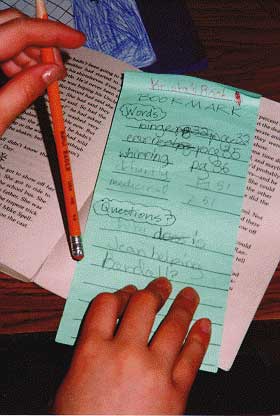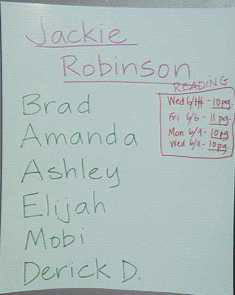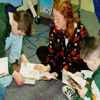Return to
Structure: Grades 4-8
- early in the year, model key components
with read aloud
- usually 3-4 rounds of literature
circles per year
- sometimes begin with whole class reading the
same book (in anthology or class set of one title)
- alternate literature circles with guided reading
instruction
- begin with all students doing the same extension & response
projects -- gradually add choices
The following calendar
shows you Lori's first year of literature circles -- the books she
selected and her reasons for choosing those particular books, and
her teaching/learning focus:
|
Month |
Book Selections &
Topic/Theme/Genre |
Teaching/Learning
Focus |
Books Chosen Because . .
. |
|
September - October |
|
Developing a classroom climate
in preparation for literature circles |
|
|
November - January |
Whole class: Dear Mr.
Henshaw |
Learning the structure of literature
circles |
Whole class set was available |
|
February |
Three choices: Humor books |
Learning the structure of literature
circles |
Topic interested the students
and the books were available |
|
March - April |
Themed unit: Taking Action to
Care for Others
(click here for book
list) |
Refining literature circles
Developing conceptual understanding: What it means to care for
others |
Books related to theme |
|
May |
Four choices: Biographies
(click here for
book list) |
Refining literature circles
Elements of biography |
Books represented excellent examples
of biographies |
|
June |
|
Wrapping up the school year |
|
Return
to top
| Literature
Circles: Unit-at-a-Glance |
- each unit lasts about 3 weeks for
reading & discussion, one week for extension project
- sometimes tie books together with
broad human theme (e.g., Taking
Action to Care for Others), by author, or by genre (e.g.,
biographies)
- book talk on the first day, students choose
books; I try to honor student choice whenever possible
- I aim for 4-5 students in a group
- I help students divide up the number of pages in the book by
the number of days theyíll have to read. This often takes
a few mini-lessons: "How many days do we have available
for reading? How many pages in your book?" "If you
divide the number of pages by the number of days, how many pages
will you need to read each time?" "What makes a logical
stopping place (help students see that sometimes they may need
to read more or fewer pages to fit chapter ends or logical pauses
in the book)?"
- students have a special journal for each literature circle
- 1-2 response projects in a round, tied to a focus such as character
study (bookmark), sequencing (story hat), understanding main idea
(main idea belt)
Return
to top
students read 4 days each week
we write in journals whenever we
read or meet in groups
I give a mini-lesson each week on a reading/writing
strategy and one on a procedure related to literature circles
(specific lessons come from our debriefings)
groups meet to discuss 1-2 times each week;
all groups meet simultaneously -- I roam with a clipboard to take
anecdotal notes
I read with most struggling readers every day to check in on
how they are doing
if they get behind, students make up reading at silent reading
time
The following calendar
shows a typical week during Lori's literature circle cycle:
Literacy Block -- 9:30 - 10:45
a.m.
|
Monday |
Tuesday |
Wednesday |
Thursday |
Friday |
| Read
Focus lesson on discussion
procedures
Discussion: All groups
Debrief discussion |
Focus lesson on reading strategy
Read
Writing linked to strategy
lesson
|
Journal writing
Focus lesson on discussion
Discussion
Debrief discussion |
Focus lesson on reading strategy
Read
Journal writing
|
Focus lesson on discussion
Discussion
Debrief discussion
Journal writing |
Return
to top
Literature circles take place during
my 1-hour Reading Block (usually 9:45 a.m. - 10:45 a.m.).
The exact activities for each day will vary throughout the 3-4 weeks
of the literature circle cycle. Below are three of the most
common variations for each day's agenda:
Variation A:
Read: 20 minutes
Write in journal: 15 minutes
Meet in group to discuss: 10 minutes
Debrief as a whole class: 10 minutes
Variation B:
Share picture book for reading strategy mini-lesson: 20 minutes
Read: 20 minutes
Writing linked to mini-lesson: 20 minutes
Variation C:
Meet in group to discuss: 10 minutes
Reflect on discussion/whole-group debrief: 15 minutes
Read: 20 minutes
- when students
finish at varying times, they work on response project or independent
reading
- I always try
to debrief how things went -- that's where the literature circles
mini-lessons come from
Return
to top
class-generated rubric for journal
checklist or anecdotal records
for discussion. I figure out what Iíll be looking for first
(e.g., participation, questioning, and/or listening)
response & extension project
(culminating) show understanding of book, theme, characters, etc.
quality work on bookmark &
golden lines
Return to top
Organizational
Structures That Work in My Class:
Folders
for students to keep journal entries, pocket for focus lesson
work, "Golden Lines," self-evaluation sheets, project plans.
Bookmarks
to identify books and keep notes as students read.
Boxes for
book sets and folders for each group. Cereal or pre-fab
boxes work fine.
Wall postings:
GuidelinesDecide
as a class how they will prepare for literature circle meetings,
when and how reading can be made up, what makes a discussion
run smoothly. Click
here for more information on helping students develop discussion
guidelines.
Group
listsA chart showing who is in which group and what
pages they have decided to read.
Journal
promptsKeep a running list of ideas for ways to start
and what to include. Click here for ideas on using
prompts in discussion; click here for ideas on using
prompts in written response.
Return to top
Return
to Structure: Grades 4-8

Folders for journal entries, with
a pocket for focus lesson work,
"Golden Lines," self-evaluation sheets, project plans
Return to
Organization

Bookmark to record "Wonder Words"
(words students would like to discuss in the group), and questions
Return to
Organization

Boxes to hold each group's books
and journals
Return to
Organization

Class-generated Discussion Guidelines
Return to
Organization

Chart: Members of the Jackie
Robinson: The Bravest Man in Baseball group
Return to
Organization

Prompts for Discussion and Journals
Return to
Organization |






